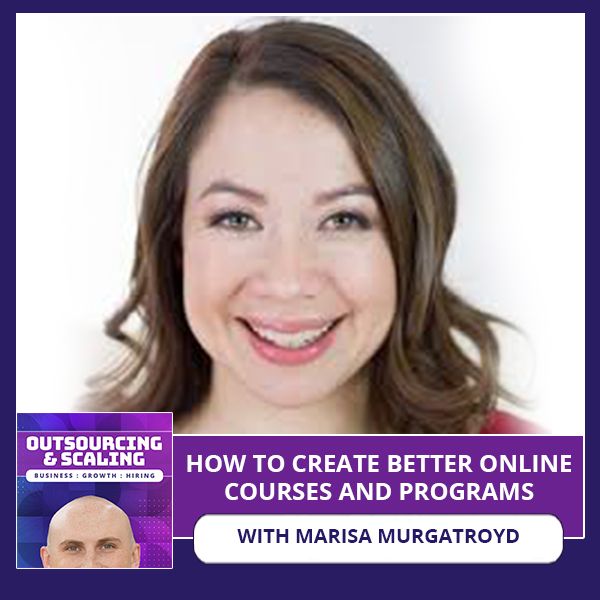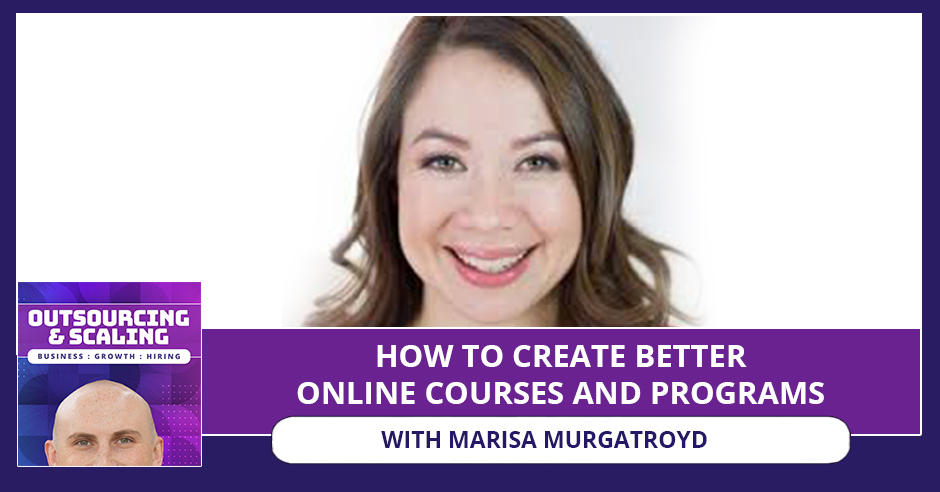


Did you know that 97% of online courses fail? While creating courses may be a great way to leverage your time and scale your business, all of these things are for naught if they are not utilized well by your students and customers. Helping you overcome the stumbling blocks that keep people from completing your courses is guest, Marisa Murgatroyd. Marisa is the Founder of Live Your Message and the Creator of the Experience Product Masterclass through which she helps people create better online programs. In this episode, she shares some insights, tips, and tricks on how to make your courses produce fewer refunds and more repeat sales. On growing her business, Marisa then tells us about her entrepreneurial endeavors—from how she founded her business down to how she structures her hiring process, especially with your virtual assistants.
—
Listen to the podcast here:
[smart_track_player url=”https://www.podetize.com/statsapi/www.podetize.com/wp-content/uploads/fileuploads/11-5b145ef137b51b3d1af0633e9305c43d/02/2020/867f68884e1c5067af541fb1f93ee23a.mp3″ title=”How To Create Better Online Courses And Programs With Marisa Murgatroyd” artist=”Nathan Hirsch” image=”https://freeup.net/wp-content/uploads/2019/04/OAS.png” ]
Download the audio file here.
How To Create Better Online Courses And Programs With Marisa Murgatroyd
My guest is Marisa Murgatroyd. She is the Founder of Live Your Message and the Creator of the Experience Product Masterclass, where she helps people who facilitate online programs get much better results for their students faster. We were talking before about getting people to convert courses that finished them leads to fewer refunds, leads to more repeat sales. We’re going to talk all about that. First, let’s take a gigantic step back. What were you like growing up as a kid? Were you a straight-A student? Were you a rebel? Did you always know that you wanted to be an entrepreneur?
I was a straight-A student. I was also a rebel. I didn’t think in my mind, it was farthest from my thoughts that I was an entrepreneur. I was more of an artist, completely impractical. I loved to read books. I would go to my room and read three books in a sitting. I was a geeky, nerdy bookworm. My brother was an entrepreneurial one. We’d have these block garage sales in the community that I lived in. He would wake up at the crack of dawn and buy all the best stuff. He’d mark it up and resell it. I had no interest whatsoever in business, in marketing. I wanted to develop my craft and artistry. I was great at making things look good, sound good and telling good stories. It took me many years to realize that those three skillsets were the basis of all business and marketing. I had by becoming an artist developed all the skillsets that you need to build an incredible online empire. It took me 30 years to realize that because sometimes you don’t know what you don’t know. In one context skills have little value. In another context, they are worth their weight in gold.
Did your brother ended up becoming an entrepreneur too? Did he go off in a different direction?
He did not. Here’s the interesting thing is that even though he’s entrepreneurial, my brother loves safety and security. He’s a family man. He wants to provide that steady paycheck. You have to have a higher risk threshold as an entrepreneur. I’m all about as an artist was more spontaneous than the risk, into creativity and into my own resourcefulness being able to solve problems. It’s interesting even though I didn’t think I was into business, money and all of that, the creativity and the ability to take risks, play and explore. I call it putting on your inventor’s hat. I always tell my students, I’ve got about 5,000 students around the world, is that you’ve got to look at your business like a creator or an inventor when you’re trying things. You’re tinkering in the experimental lab that is your business and that didn’t work. Being willing to have a little bit of distance, perspective, objectivity and not to look at every failure as if it’s a personal affront on my self-worth. That’s a way to take it. If you look at it more like a creative or an artist, this is a canvas. I’m exploring. It changes the game because even though it’s an expression of who you are, a little bit less personal, where every failure and every mistake is like, “I’m not worthy.”
I talk to entrepreneurs all the time and they’ll be like, “How did you implement this thing that I can implement in my business?” I’m like, “You don’t understand it. It doesn’t work like that. You have to try it out. You have to see what works. You have to adjust to what doesn’t work. It’s all about figuring it out.” That goes for every single channel. I feel like a lot of people get caught up in the gurus being like, “If you do it this way, you’ll have success.” Those people can provide great information, but if you don’t have that mindset of tweaking and adjusting to your business model, to your clients, you’re going to struggle to grow and scale that thing. Would you agree?
I would absolutely agree. One of the biggest challenges that I have in building a good team, which is what I know you’re all about, is that I’ve got that resourcefulness mentality of letting me go and figure it out. A lot of times, the team members are asking me questions. They could easily ask Google or we have to assist admin on our team. They’re like, “I can’t do these Google Optimize split tests because I haven’t been trained on it.” It’s like, “Google how to do a split test, Google Optimize,” and building the resourcefulness. That’s not a characteristic that everybody has.
We had Austin Netzley as a guest on our show. I asked him what he looks for when he hires people and he said, “The ability to figure crap out.” That was it. It’s such a key tool for hiring. Before we jump into the hiring side, I do want to hear your story. I want to hear how your first entrepreneurial endeavor was? How’d you get to founding this business?
The first one was interesting because before this I was a documentary film director and producer. I was hired as a filmmaker. I was getting paid as a filmmaker, which at least is an accomplishment in and of itself. I was working with a production company. I loved the work. I didn’t always love the job and I didn’t love the boss. One morning, I was sitting there and working on edit at the time. I had to get something ready for printing on DVD. DVDs barely exist anymore and most people don’t have DVD players in their computers and stuff like that. It was a big process of getting the color correction dialed in and all those finishing touches to print. When you go to print, it’s like cross your fingers and hope for the best because it’s going to be out there forever in that format.
Things have changed a lot, but I was up there trying to finish this film. My boss walks in and it’s 1:00 in the afternoon. She’s showing up. She’s been at home all day, having a leisurely day at her computer. She comes in like, ‘I forgot my power cord, can I have yours?” I said, “No. To be honest, I didn’t have my computer plugged in. I don’t have enough battery power to sustain this. We need to get this film to print it.” Plus, there are all of these production assistants in the office that she could have asked. She didn’t need to ask the producer-director, but she at that moment decided to teach me a lesson. She said, “Marisa, that computer you’re working on, I own that computer and that power cord, I own that power cord too so give me the power.”

What she didn’t say is, “Marisa, I own you.” That’s what I heard at that moment. I had this realization that I had spent the last few years building someone else’s business for $1,000 a week, where basically if I didn’t work, I didn’t get paid. I wasn’t even a contractor. I didn’t even have benefits. I had no backend stake in all of the creative output that I’ve been producing, no intellectual property, no royalties, none of that. I didn’t even own the power cord that I was using for my computer. We ended up going on it back and forth and I ultimately had to give her the power cord. At that moment, when I did, I felt like I was giving away my power.
I realized that I was doing what many other people do in the city of Los Angeles, the city of fifteen million people is that I was going to a job every single day that I didn’t necessarily love. Why was I doing it? At that moment, I realized that I had the potential to go out on my own, to build my own empire and to create my own wealth and my own asset value versus building somebody else’s who didn’t even appreciate the work that I was doing. That was the moment where I realized it was time for me to do something else, but I had no idea what that could look like. Even as a filmmaker, I thought I’m going to be broke for the rest of my life. What skills do I have that anyone would pay me for? Making things look good, sound good and telling them good stories don’t have a lot of value. As an artist, I didn’t think so.
Walk us through year one of starting your own business. That’s the make or break time, especially if you come from either corporate or working for other people, whatever that is. What did that first year look like for you?
It was a bit like the Wild West. I had no idea what I was doing. I’d been working for other people my entire career. I was in my early 30s. I didn’t know what my niche was. I didn’t know how to do marketing. I didn’t know any of that. I started going and learning from all the greats. They are people who are now my friends, my joint venture partners, and my clients. People like Don Crowder, Eben Pagan, Jeff Walker and all of these people. I started to figure things out as I went. At first, I started with a service-based business, which is where a lot of people start because it’s the easiest business to begin. I was offering web design services and branding services. I got my first clients at those events and at those training. It was hard.
I was working hard for each $3,000 to $5,000 contract. It’s funny because my packages now are $50,000 plus. At the time, I was offering something for $3,000 to $5,000, calls every single week, chasing every asset and you name it. It’s interesting because about a year in, I was offered another job. It wasn’t even something that I was looking for, but it was a job that would’ve been a dream job a year or two before as a senior multimedia specialist for a nonprofit. I ended up taking the job doing video, social media and web work. As soon as I got there, I realized that I was never meant to work for someone again.
It took leaving and coming back for me to have that realization. I used that job as what I call the golden parachute, where I was making a steady paycheck. I could do nights, weekends and on the side, be working on building my business. Instead of working in a state of desperation as I watched my bank account drain day after day, I had a little bit of buffer to start making smarter decisions and look more long-term in the business. I usually recommend that people don’t quit their day job until they’ve at least proven a business model.
I met a freelancer a few months ago and he was selling a course. He was sick of being a freelancer, sick of working with or for other people. He was asking me like, “Should I quit and go all for it?” My question was, “Have you proven the concept? Have you proven that you can sell that course and scale that business over and over?” The answer was no. He had some more work to do and continue to work for those clients. Talk about your first hire. What did that look like? How did that go?
My first hire was someone who worked in a nonprofit with me. She had a motorcycle and a Mini Cooper. She was this young Asian woman in her twenties. She had some computer skills. She would design my first slides, not nearly the caliber of design that we had now, do some technical things and pieces like that. Eventually, after a year or so, she’s like, “I’m not interested in this.” I didn’t know what I was doing. It was trying to get someone to support with all the little bits, the pieces and things like that. I also ended up in business with my husband and my business partner now. That helped too because we divided and conquered where he did a lot of the stuff that I didn’t do. I was the face and voice. He’s great at behind the scenes marketing and technical stuff as well. Together, we were able to do a lot and still do a lot and use a little bit fewer team members at the start. Now we have a team of about fourteen full time. We do have another network of maybe twenty different contractors, coaches, people who receive money from us on a regular basis but aren’t full-time contractors.
You have at least one full-time assistant in the Philippines. Can you talk about what that’s like? A lot of people reading are trying to hire their first VA or they’ve struggled to hire VAs in the past. How do you structure that? What does she do? What do your people know about that?
She is amazing. She’s been with us for a few years. She’s our longest-term contractor. We adore her. She’s got more institutional knowledge than anybody else and is super resourceful. She has great conversational English skills. In terms of how we structure that, she gets an hourly. The hourly is maybe $7 an hour. It’s high for someone in the Philippines in the sense that she’s been with us for a few years. We’re giving her another raise starting in January as well because she’s dedicated a huge part of her life to us. She’s seen us through ups and downs, other people coming and going. She’s maintained a huge amount of loyalty and reliability for us over the years. We adore her.
I want to jump into courses. That’s your thing. Some people reading probably have a course. They probably had a little bit of success selling a course. What does the average person not know about selling courses?
This is the area that I’ve been pioneering. What the average person does not know is that even though it’s an incredible way to leverage your time and scale your business by creating one to few or one to many products and programs, most people don’t know that the failure rate for online courses is 97%. Meaning that 97% of your students or customers who are investing in these programs don’t complete the programs and get the results. Most people who are creating programs, they may know how to do something themselves, but they don’t know how to facilitate in a way that gets their students super hooked on taking action and getting results. It’s different to accomplish something in your own life than it is to help someone else accomplish it. The other thing people don’t know is that as entrepreneurs, as people who are already successful entrepreneurs, we’re oftentimes built a little bit differently than the people who need courses to learn things.
For example, it’s known that entrepreneurs are intrinsically motivated. It means we’re motivated by our inner drive and our own inner sense of reward. About 70% of the population is extrinsically motivated, which means they’re motivated by external validation, meaning they need the structure, the validation, the prompts and the accountability from other people to complete something. You’ve got these intrinsically motivated people making programs that would help them, but not to help someone who is different than them who might be extrinsically motivated. You’ve got to realize that if someone needs a course to do something, it’s not something that comes naturally to them for the most part. It’s something that they may be struggling with. Why does this even matter? You’re like, “My main focus is getting customers. If I don’t even have customers, this is a high-class problem.”

The thing is that there’s more competition for online courses and your reputation is based on your student-client results. People don’t trust marketing, claims, and promises anymore. They want to see all the different success stories and testimonials. They’re going to ping, private message and Facebook message your testimonials to validate them and make sure that they’re legit. If you’re having a track record of getting people results, your sales will increase as well as your referrals and your repeat customers. You’re going to develop that reputation. I always say that while most people think that the most important moment in your relationship with your customer is the moment they buy, I believe it’s the moment right after they buy and how you start to deliver a phenomenal experience that delivers on the promises that you made. That’s where you know a team is going to be able to support you in creating that incredible customer experience that has people referring you and buying from you over and over again. You’ve done something that few people have done for them before, which has helped them get results, help them achieve their biggest goals in life, overcome their greatest challenges and do the transformational work.
How do you keep track of that data? You have 5,000 students. I’m sure other people there have sold thousands and thousands of courses. How do you keeping track of where everyone in the process and what type of help people need so that you can have your team act accordingly?
I teach a methodology I call the experience formula, which is ten things to stack into your programs to experience escalation. The unstoppable momentum from saying yes to the mission to mission accomplished, to achieving the results and ten things you want to avoid. One of the principles is constant wins. Students feel like they’re winning every single time they engage with us. We’ve created a point system. Every time someone watches training, they get one point, every time they complete an action, they get two. We have these overachiever points, which are optional training and things that they get what we call Triple XP, Triple Experience Points. We call them the overachiever track. We call it Porn for Overachievers. When they click things off on the main track, it goes caching.
When they click things off on the overachiever track, it goes. We can log into the backend at any time and see exactly where every single student is. Say there are 50 points available, we can see this person has 50, 50, 50, 50, 49, 48, 47. This person has zero. We’re able to say a couple of weeks into the program, run what we call an operation unengaged student rescue campaign to reach out to people who have not gathered any points or who have less than five points, for example. The interesting thing is we did this. We reached out to a student. Her name was Jennifer Hovis. She is the kind of person who falls off of every single program she’s ever signed up for.
She said because we reached out because we cared and she had never had that experience of any program she had ever taken before. My customer support team reaching out personally to her, sending her a personal message, she jumped back on the wagon. She ended up not just finishing this program, she made $250,000 in the program. She went on and spent another five figures with us and our other programs and services. This is why this stuff works. Someone who would have fallen off and we never would have heard of them before ends up becoming a huge success story and continuing to make five-figure investments with us.
You said some of the things not to do, can you share some of those?
The first principle is what I call to mission. The mission is the specific goal, outcome or result. What your customers and students are going to be, do, feel, have overcome or achieved through your program. It’s got to be clear and specific, it’s almost binary. There’s no uncertainty about whether they’ve completed the goal of the program or not. Most people who are creating products make the mistake of what I call serving too many masters. Meaning their program is trying to do too much and get people too many different outcomes simultaneously or the outcome itself is invisible. It’s about stuff. It’s like a bunch of information, teaching a bunch of skills, whatever it happens to be. There’s no clear mission accomplished state. There is no clear after state. If people don’t know what winning looks like, they’re not going to keep playing the game.
What about getting a sale or are you more focused after the sale?
No. We have three seven-figure product lines. These same principles ironically can be applied to marketing as you apply for course creation. If you’re able to get people to win and create this momentum in your marketing campaign itself, they’re way more likely to buy from you than if they’re not fully engaging. A lot of data science says that if you can get people to take three actions, even if they’re small, simple actions, they’re way more likely to buy from you. This is called results in advance. How do you get people results in advance? We have extremely high conversion rates on our programs. We have extremely high EPCs, Earnings Per Click, for our joint venture partners in our programs. We’re one of the few companies that are seeing our launches go up and up every single year. Part of that is because we apply these same principles to marketing to create super sticky marketing, super sticky products, but our reputation and our track record speak for itself. Every launch gets bigger.
You spoke about the importance of good, legit client testimonials. How do you go about gathering that and spreading the word?
During our last program, we had 700 people sign up for the program. We received 700 pages of testimonials. Now that doesn’t mean that every person submitted a testimonial. Some of these were 5 or 10 pages long, but we integrate it right into the program. When you define that clear mission for your program, you can also define a mission accomplished. The mission of our Experience Product Masterclass is to design a market to make $2,000 or a whole lot more from an experienced product, not an information product, but an experienced product in ten weeks or less.
When they achieve the goal, they hit this big goal mission accomplished button. That creates a bunch of surprises. I call them unicorn bombs. It goes right to submit your story. One of the things that we do is we give them up to 10% back on the money they’ve earned in what we call Super Bucks, which is our linear message currency towards future programs or they can pay it forward to the Live Your Message Foundation and support a future student to go through the course. They’re incentivized to submit their story in order to claim the Super Bucks or make this donation to the foundation.
Even if they don’t hit mission accomplished, but they graduate, we also have graduation incentives like they get a lifetime certificate to use our trademark term experience products to describe their programs. Because of that, we’ve incentivized the completion state and/or the graduation state and people are clicking the button to claim their graduation and their mission accomplished bonuses. As part of that, they have to submit their story and submit their results. We’ve had 700 pages in 2020, 500 pages in 2019, maybe 300 pages in 2018. We have over 1,500 pages of testimonials. That’s legit. We didn’t have to chase anyone for any of them. It was built into the product. That’s a part of the experiencifation that I teach and how you build all this into your products, so you don’t even have to work for it.
Maybe we’ve got our own software, the time clock at-home storage, freelancers and profiles, all that stuff. I’m thinking about how I can incorporate that the same way that you do with your course? What did we miss? What else should people know about courses? I’ll have you tell people where to reach you out for that.
I always like to quote the late great Zig Ziglar. He said that you could have everything in life you want if you’ll help enough other people get what they want. The mentality that a lot of people go into creating online programs worth is a little bit reversed. It’s like how I can get people to buy what I want to sell versus how do I create something that’s going to get many people results that the product itself is virtually going to become viral? People are going to love it. They’re going to refer it. Your conversion rates are going to go up and up. That’s what I teach people to do. It’s how do you create super sticky products, programs, and courses that get people hooked on taking action, getting results, ultimately referring you and buying from you over and over again. When you reverse the normal hat that most people look at programs for, which is how I can make more money, you will make way more money. We’re doing well, but you’re going to do it in a way that feels super good to you and your customers. In the end, your business will come out on top.

Where can people find out more about you? What are you most excited about going forward?
If you go to LiveYourMessage.com/Nathan, I’ve put together my viral product checklist of the ten core experiences that you need to stack in your products and the ten experiences you want to avoid if you don’t want to send good customers into rabbit holes. You can decimate your refund rate and increase your completion rate, your referral rate, your repeat sales rate. If you go to that website, you can go ahead and grab your own copy of that checklist and learn how you can make your programs way stickier both in terms of getting people to buy and getting people to complete.
I’m excited about creating a lot of the evergreen marketing and delivery systems at our company. We in the past historically have run our business based on one seven-figure launch and one seven-figure live event a year. That got us going, but I’m getting older. I want to have more consistency, more stability. My goal is $250,000 a month in passive evergreen income. If I can do that and we’re getting closer and closer, the whole payroll, the whole company, all of our contractors are covered and our contractors are covered without me having to ever launch or step on a stage. I’m still going to do that and that becomes a gravy. I’m excited about cracking that nut.
This has been great. I appreciate your time. Thanks for coming on.
Important Links:
- Live Your Message
- Experience Product Masterclass
- Austin Netzley – past episode
- LiveYourMessage.com/Nathan
About Marisa Murgatroyd
 Marisa Murgatroyd is the Founder of Live Your Message and the creator of the Experience Product Masterclass where she helps people who facilitate online programs get much better results for their students, faster.
Marisa Murgatroyd is the Founder of Live Your Message and the creator of the Experience Product Masterclass where she helps people who facilitate online programs get much better results for their students, faster.
